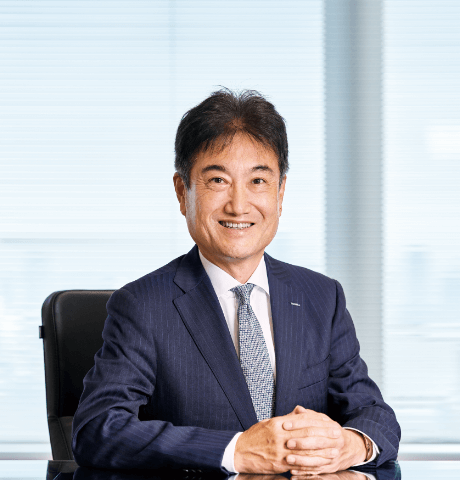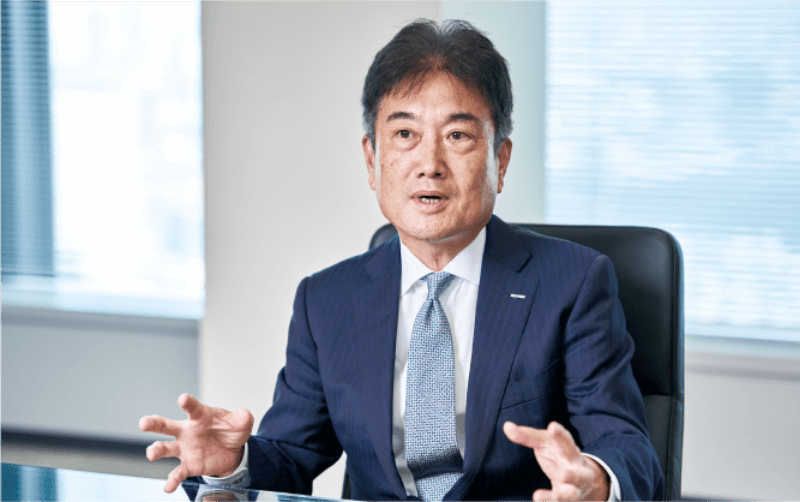- Value Creation
Story (PDF) - CEO
Commitment - COO Growth
strategy - CHO
Commitment - CFO
Commitment - Development
- Corporate
Governance

Restructuring our human resources investment strategy means investing in people to achieve sustainable growth
Satoshi Miyazaki
Director and Executive Vice President,
Chief Human Resources Officer (CHO)

Capcom exerting its presence in a continuously growing game market
In my previous career in the world of banking, I had the opportunity to see a variety of corporations. When looking at the companies in the game industry, I had the impression that the industry’s global market was expanding as it shifted to digital. Within that market, I was aware that Capcom had extremely high potential for growth due to its strong IPs and superior R&D capabilities.
I then joined Capcom myself in 2021, and my understanding of the company remained much the same; from an insider perspective, I could see firsthand that the level of management and the company were definitely rising.
However, no matter how good a company’s trajectory, it will still have issues.
Since 2013, we have been hiring more than 100 new graduates each year, while also aggressively carrying out mid-career hiring to acquire personnel who can hit the ground running. As a result, as of the end of June 2022, the company has 3,350 employees on a consolidated basis and 3,052 employees at Capcom alone, of which 2,494 work in the development division. In recent years, attitudes toward work among younger employees has diversified, and it is essential that we have an accurate understanding of these employees’ values and respond to their needs. In addition, we have gathered talent from 33 different countries here in Japan, so not only do we have to respond to the diversifying values of Japanese employees, but it is also critical for sustainable growth that we meet the needs of our foreign national employees.
In the last five years, we have sold our content to a maximum of 234 countries and regions, which means that on a business basis, we can consider ourselves to have already joined the ranks of global corporations; however, in order for us to expand our business to all the corners of the world, we need to transform ourselves into a truly global corporation.
Restructuring our human resources investment strategy for sustainable growth
Today, the success of Capcom’s digital strategy has led to achieving nine consecutive years of increased operating income. In addition to the strong IPs and development capabilities Capcom possesses, we have been working on expanding sales through the utilization of past sales data in recent years. The results of running various forecasts with this data have shown that there is still sufficient potential for further sustainable growth.
It is our development division that underpins our strong IPs and our development capabilities, and the labor costs that appear in our financial statements are in one sense an expense, but in another they are also an investment in our growth. We also need to digitalize operations in our operational, sales, and administrative divisions in order to identify issues and devise solutions that are in line with the changing business environment.
Recognizing the need to review and restructure our human resources investment in order to maintain sustainable growth, we have recently revised our human resources investment strategy. Allow me to explain the main elements of the strategy that is currently underway.
1. Revision of compensation policy and introduction of stock-based compensation system
Capcom has long had a system of compensation based on contribution to business performance. However, while we achieved significant year-on-year increases in operating income of 51.6% in fiscal 2020 and 24.0% in fiscal 2021, the compensation granted based on the conventional system was not sufficient. We therefore looked beyond the constraints of the scheme, and subsequently revised the compensation system itself, resulting in an average 30% annual increase in base compensation for fiscal 2022. In addition, we introduced a stock-based compensation system with the objective of helping our employees understand that it is their efforts that lead to an improved market reputation for the company, and that this will be reflected in their compensation.
To sustainably achieve our objective of a 10% increase in operating income each fiscal year, we designed a system where the improvements in the company’s business performance will lead to an increase in personal compensation, so each individual employee will be rewarded according to their contribution. We will continue to refine the new compensation system in line with changes in the management environment and employee sentiment.
2. Reorganization of human resources-related operations
(1) R&D Human Resources Department
In terms of organization, the Human Resources
Department had been responsible for all human
resources operations at the company, including that
of the development divisions. In particular, work in
the development divisions, which accounts for more
than 70% of the company’s employees, is different
from that of the operational, sales, and administrative
divisions, and the development divisions have a unique
organizational structure that has been cultivated
over many long years. In terms of the organizational
chart, the structure is organized by operations, such
as programming and graphics, but in actual content
production, it resembles a kind of project team, where
the team produces content in a dynamic manner.
To manage these operations, we believe there is a need for a specialized human resources organization in the development divisions that can respond to their various needs. We therefore established the R&D Human Resources Department under the supervision of the director in charge of the development divisions.
(2) Health and Productivity Management
Department
Next, we established the Health and Productivity
Management Department to identify the diversified
work attitudes and needs of employees and solve
issues. We are aiming to not only address employees’
wellbeing, but to also respond to their various
concerns and issues, such as overtime management
and harassment. Therefore, we have established two
consultation desks within the Health and Productivity
Management Department; one for support in Japanese
and one for other languages. The department was
placed under the supervision of the director in charge
of corporate management so that awareness of
problems and issues in the field can be directly
communicated to management.
(3) Corporate Planning Department Human
Resources Strategy Team
Next, we established the Human Resources Strategy
Team within the Corporate Planning Department to
take on a human resources planning role with respect
to items such as hiring and compensation. The team
promptly identifies issues related to securing human
resources in the medium- to long term, including
systemic problems, and formulates countermeasure
policies. Thus, we have created a system to identify
and respond to issues within the Corporate Planning
Department, which is directly linked to management.
(4) Human Resources Department
The Human Resources Department is primarily
responsible for improving human resources operations
and employee services. The Human Resources
Department compiles human resources-related data
in cooperation with other departments, and works
in a steadfast manner to carry out training, hirings,
resignations, and job rotation practices while working
with other human resources-related departments
to identify and address issues related to personnel
operations.
3. Improving the work environment
We must proactively respond to the changes and diversification of employees’ work attitudes and values. At Capcom, we conduct the stress check stipulated by the Ministry of Health, Labour and Welfare, and utilize the results to identify the issues in each department and work site.
In addition, we held a harassment prevention training session for executives and managers in fiscal 2022, where we shared the changes in attitudes among younger employees in recent years, our awareness of issues with how to engage them. Although this may be dismissed as an issue with corporate culture, we are committed to proactively working to better our corporate culture to enable it to respond to changes in employees’ attitudes toward work, even if the endeavor takes time.
In the last several years, the employee turnover rate had been hovering around 4%, but last fiscal year, it rose to the 5% level. We believe that this is due to a convergence of various factors, including recent changes in work attitudes, headhunting, and dissatisfaction with company policies. At Capcom, when an employee leaves, the responsible human resources department conducts an exit interview. Within those interviews, we have been able to identify company issues and reflect them in our policies, one of which was compensation. In addition, there have been many cases where foreign national employees have made us aware of issues with our benefits programs and lifestyle support for living in Japan. We will work to provide quicker responses and make improvements to these issues.
4. Personnel diversity
As our content spreads throughout the world, it is essential that our employee composition is diversified in terms of nationality, and we need to promote further diversification in our workforce to support Capcom overall. For our game content to reach throughout the far corners of the globe, the company itself must proactively gain an understanding of the situation in the many countries of the world. In this respect, the issue of diversifying the nationality of our employees has become clear. When we look at game user data, personal attributes such as gender and age composition are all changing significantly.
-
The number of female employees as of March 2022 was 637 (composition ratio of 21%), which is a 42% increase compared to five years prior. Meanwhile, there are 191 foreign national employees (composition ratio of 6.3%), which is a 93% increase over the same period. Female managers account for 5.5% of female employees and foreign national managers account for 3.7% of foreign national employees. We have been proactively pursing diversification of our personnel these last five years, but when we think about the issues we are currently facing, I believe these numbers are not yet satisfactory, and we will work to further promote diversity.
-
5. Establishing the Chief Human Resources Officer (CHO) position
As the issues mentioned thus far must be handled at the management level, and because the four human resources-related departments fall under the supervision of different directors and executives, the company established the position of Chief Human Resources Officer (CHO) to coordinate all of the various human resources issues within the company. Our intent is to steadily implement reforms to respond to the issues that need to be addressed in order for Capcom to achieve sustainable growth.
Capcom’s digital transformation (DX)
The cornerstone of our digital strategy is data analysis. Three years ago, the Data Analysis Section was established within the Marketing Strategy Department, and we have begun organizing data from the late 2000s onwards, which can be tracked in the current system. Now, we are able to grasp the status of game sales in more than 200 countries and regions around the world by country/region or title. We could have hired expert data analysts or system administrators from outside the company to do this work, but we found it necessary to organize and analyze the data with an understanding of the transaction practices, product traits, and service content that are unique to the game industry, and we therefore appointed employees from within the company who were judged to be suitable for these positions. We will continue to amass data going forward, and we expect to further improve the level of data analysis and utilization while enhancing the accuracy of business forecasting. We must also review our workflows in line with changes to our business model in the operational, sales, and administrative divisions.
We will promote systemization and procedural reforms to eradicate outdated processes and build efficient workflows that can swiftly respond to issues.
Strengthening information sharing with employees
I can see clearly from the various data over the last decade that Capcom has moved up a stage.
At Capcom, based on the management policy of our CEO, we are building a framework to quantify management information, identify issues, and develop measures to address them. This quantified data is shared with our employees, depending on their position. However, in today’s rapidly changing environment, inevitably there will be differences among employees in their ability to read the numbers.
Based on our awareness of this issue, from the fiscal year ending March 2023, we have been holding briefings for employees on the status of our business. At these briefings, we shared our growth trajectory based on the management policy for the last decade and its contributing factors and issues. Furthermore, the briefings provided the opportunity to not only send a message from management, but also to hold a Q&A and opinion exchange session. Three briefing sessions have been held thus far, with a total of 385 employees participating, and at the management level, we feel there has been a good response to sharing our awareness of issues. In response to requests from employees, we plan to continue holding these briefings regularly.
The aim of our human resources investment strategy
-
In following our proactive hiring policy, we have been striving to strengthen our development team, and we will continue to do so in order to achieve sustainable growth. On the other hand, we believe that the human resources we will require will change due to changes in the game industry and market, and we must address this. We must diversify the human resources we secure while strengthening our content production capabilities and improving productivity. There is also a need to evolve our system of data-driven management. Even greater changes are waiting for us in the next 10 years than those that have taken place in all the history of the game industry. We will promote our human resources investment strategy to create a foundation that can nimbly respond to those changes.
-

CAPCOM INTEGRATED REPORT 2022
PDF (Complete version) (PDF: 12.2MB / 104 pages)
PDF (by section)
Value Creation Story
(PDF: 3.5MB / 24 pages)
- Create Financial and Non-Financial Value
- Corporate Philosophy
- Value Creation Model
- History of Value Creation
- Major Intellectual Properties (IP)
- Effectively Leveraging IP
- Digital Strategy / Human Resources Strategy Performance
- ESG Highlights
- Business Segments Highlights
- Financial Highlights
- Medium- to Long-Term Vision






